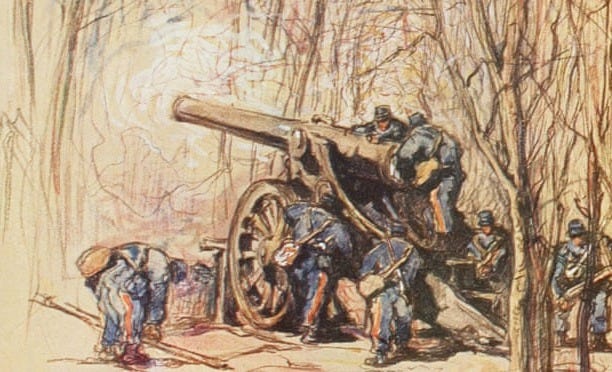Sound and Flash
Tactics Made Simple

For the artillery, the implications of the adoption of indirect fire were favorable. Among other things, the life expectancy of the average gunner was greatly increased. For the infantry, however, the results were disastrous. Hidden guns that proved unable to do serious damage to other hidden guns retained their ability to deal damage to foot soldiers. Indeed, because such guns were so difficult to knock out, the firepower available to heap additional misery on the ground-hugging infantryman increased considerably.
To give this phenomenon full credit for causing trench warfare would be less than accurate. Other factors - operational, tactical, and technical - also played big roles in the onset of position warfare. Nonetheless, once trench warfare started, the difficulty of knock- ing out the enemy artillery was one of the major contributors to making a successful assault beyond the closest enemy trench a rare event indeed. It is thus not surprising that the year 1915 saw the development of a number of techniques for locating enemy batteries.
The first of these to appear was “flash spotting. ” Each time that an artillery piece was fired, the gasses and still burning powder that erupted from the muzzle produced a visible flash. In flat country, this flash could be seen in daytime. On more irregular ground, the observers had to wait until night to see the reflection of the flash on the clouds.
If two or three observers equipped with compasses determined the azimuths that connected their positions to the flash, the flash (and thus the gun that produced it) could be located with great precision.
On quiet fronts, where shells were rationed and guns fired occasionally, this technique, plied by a small band of sharp-eyed and patient observers, worked well enough. When things were busier, however, the basic method fell apart. If more than one gun fired at the same time, the observers ran the risk of plotting their azimuths to different flashes.
Eventually, this problem was solved by giving observers the means of telling other observers which flash they were spotting. In the absence of radio, this was usually achieved by a system of lights and buzzers connected by telephone wire. Despite the resemblance of these apparatuses to middle school science projects, they greatly increased the ability of “flash spotters” to deal with an increasingly crowded battlefield.
The second major technique for locating enemy batteries was “sound ranging.” Like flash spotting, sound ranging was simple in conception. Most artillery shells were supersonic. When they broke the sound barrier they produced a distinct sound. This sound was as much a signature as the muzzle flash and, theoretically at least, could be used just as easily to establish an azimuth between an observer’s position and the offending gun.
The sound signature of a firing artillery piece took the form of waves. Like the rings formed in a pond around a pebble that had been dropped, these circular waves traveled outwards from the spot where shell broke the sound barrier. Because sound travels relatively slowly, listening stations placed at known intervals would pick up these waves at different times. By comparing these times to a set of established standards, an analyst was able to deduce the location of the firing gun relative to the listening stations.
In its simplest form, the listening stations consisted of men with good ears and expensive watches. These, however, were soon replaced by microphones linked to a device similar to a seismograph. The microphones converted the sound into electricity and the “seismograph” converted the electricity into patterns on paper or film. These patterns would then be analyzed to determine the direction and distance of the weapon that made the sound.
The techniques for both flash spotting and sound ranging were greatly improved by the French, British, and German armies during World War I. They were further improved in the interwar period and proved the mainstay of counter-battery intelligence in the Second World War.
In the post-war era, flash spotting and sound ranging have been largely eclipsed by counter-battery radars. Even in the age of the microchip, however, the older techniques retain one very significant advantage. A radar that wishes to search the sky must advertise itself to the world. Flash spotting and sound ranging, on the other hand, are far more discrete.
Sources
Sir Lawrence Bragg (and others) Artillery Survey in the First World War (London: Field Survey Association, 1971)
Werner Hertel Beobachtungsabteilung 6 (1936-1945): Werdegang und Weg einer Heerestruppe (Dülmen in Westfallen: A. Laumann, 1965)



"... because such guns were so difficult to knock out ..."
I am reminded of the scene in Ernst Junger's Storm of Steel, when the Storm Troops are preparing to attack in March of 1918, and the German artillery fires a furious bombardment, and as the men climb out of their trenches they realized that the British guns, their hated enemy, have been silenced, and a cheer goes up all along the front.
Incidentally, the typical presentation of the British as pitiable lambs, fed to the German machine guns by knavish louts with walrus mustaches, is contradicted by Junger, who depicts the British army and especially its artillery, as a devouring monster serviced by indefatigable demons, and skilled and brave enemies.